Heloderma
The genus Heloderma, has 5 members, the Gila monster and 4 beaded lizards, Gila monsters are large, stocky, most of the time slow-moving reptiles that prefer arid deserts. Beaded lizards are seen to be more agile and seem to prefer more humid sourroundings.[1][2][3] Their tails are used as fat storage organs. The scales of their head , back and tail are looking bead-like, containing osteoderms for better protection. The scales on the belly side are free from osteoderms. Most species are dark in color, with yellowish or pinkish markings.[4][5] Heloderma is the only living genus of the family Helodermatidae.
| Heloderma | |
|---|---|
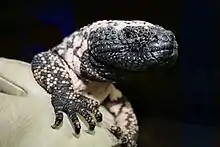 | |
| Gila monster, Heloderma suspectum | |
| Scientific classification | |
| Kingdom: | Animalia |
| Phylum: | Chordata |
| Class: | Reptilia |
| Order: | Squamata |
| Infraorder: | Neoanguimorpha |
| (unranked): | Monstersauria |
| Family: | Helodermatidae Gray, 1837 |
| Genus: | Heloderma Wiegmann, 1829 |
| Species | |
| |
All 5 lizards are venomous.[6] Their venom glands are located at the end of their lower jaws, unlike snakes' venom glands, which are located behind their eyes. Also, unlike snakes, beaded lizards lack the musculature to inject venom immediately. The lizards have to chew the venom into the flesh of a victim. Heloderma- venom is used only in defense. Venom glands are believed to have evolved early in the lineage leading to the modern helodermatids, as their presence is indicated even in the 65-million-year-old fossil genus Paraderma.[5][7]
Helodermatids are carnivorous, preying on rodents and other small mammals, and eating the eggs of birds and reptiles. They are oviparous,
The Gila monster at the everage lays 6 eggs , the beaded lizards up to about 18 eggs .[5] Compairing the different species, all eggs have a similar size, and the same holds for their hatchlings
Taxonomy
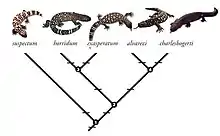
| Explanation of the numbers | |
|---|---|
| 1 | late Eocene (approx. 35 million years) |
| 2 | late Miocene (approx. 10 million years) |
| 3 | Pliocene (approx. 4,4 million years) |
| 4 | Pliocene (approx. 3 million years) |
Family Helodermatidae
- Genus Heloderma
- H. alvarezi Bogert & Martin del Campo, 1956; Chiapan beaded lizard
- H. charlesbogerti Campbell & Vannini, 1988; Guatemalan beaded lizard
- H. exasperatum Bogert & Martin Del Campo, 1956; Rio Fuerte beaded lizard
- H. horridum (Wiegmann, 1829); Mexican beaded lizard
- H. suspectum Cope, 1869; Gila monster
Members of the genus Heloderma have many extinct relatives in the Helodermatidae whose evolutionary history may be traced back to the Cretaceous period, such as Estesia. The genus Heloderma has existed since the Miocene, when H. texana lived, and fragments of osteoderms from the Gila monster have been found in late Pleistocene (8,000-10,000 years ago) deposits near Las Vegas, Nevada. Because the helodermatids have remained relatively unchanged morphologically, they are occasionally regarded as living fossils.[8] Although the beaded lizards and the Gila monster appear closely related to the monitor lizards (varanids) of Africa, Asia, and Australia, the wide geographical separation and unique features not found in the varanids indicates they are better placed in a separate family.[9]
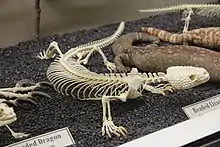
The type species is Heloderma horridum, which was first described in 1829 by Arend Wiegmann. Although he originally assigned it the generic name Trachyderma, he changed it to Heloderma six months later, which means "studded skin", from the Ancient Greek words hêlos (ηλος)—the head of a nail or stud—and derma (δερμα), meaning skin.[10]
Venom
Venom production among lizards was long thought to be unique to this genus, but researchers studying venom production have proposed many others also produce some venom, all placed in the clade Toxicofera, which includes all snakes and 13 other families of lizards.[11] However, except for snakes, helodermatids, and possibly varanids, envenomation is not considered medically significant for humans

In captivity
H. horridum, H. exasperatum, and H. suspectum are frequently found in captivity and are well represented in zoos throughout much of the world. The other two species of Heloderma, H. alvarezi and H. charlesbogerti, are extremely rare, and only a few captive specimens are known.
Gallery
- Heloderma suspectum in captivity
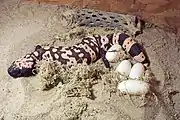 Helderema suspectum with 4 eggs
Helderema suspectum with 4 eggs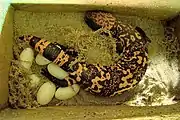 Helderema suspectum with 6 eggs
Helderema suspectum with 6 eggs Gila monster hatching
Gila monster hatching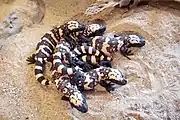 Group of young Gila monsters
Group of young Gila monsters

References
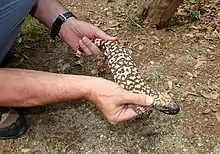
- C. M. Bogert, R. M. Del Campo (1956). "The Gila Monster and its Allies. The relationships, habits, and behavior of the lizards of the family Helodermatidae". Bulletin of the American Museum of Natural History. 109: 1–238.
- Beck, D. D. (2005). Biology of Gila Monsters and Beaded Lizards. University Press of California.
- Gila Monster and Mexican Beaded Lizard: Helodermatidae - Physical Characteristics
- Schwandt, Hans-Joachim (2019). The Gila Monster Heloderma suspectum. Frankfurt/Main: Edition Chimaira. ISBN 978-3-89973-441-6.
- Bauer, Aaron M. (1998). Cogger, H.G.; Zweifel, R.G. (eds.). Encyclopedia of Reptiles and Amphibians. San Diego: Academic Press. p. 156. ISBN 0-12-178560-2.
- http://herpetology.com/helobite.txt
- Richard L. Cifelli, Randall L. Nydam. 1995. Primitive, helodermatid-like platynotans from the Early cretaceous of Utah. Herpetologica. 51(3):286-291.
- King, Ruth Allen; Pianka, Eric R.; King, Dennis (2004). Varanoid Lizards of the World. Bloomington: Indiana University Press. ISBN 0-253-34366-6.
- Mattison, Chris (1998). Lizards of the World. London: Blandford. ISBN 0-7137-2357-2.
- Wiegmann, A.F.A. (1829). "Über die Gesetzlichkeit in der geographischen Verbreitung der Saurier". Isis. Oken. 22 (3–4): 418–428.
- . Fry, B.; et al. (February 2006). "Early evolution of the venom system in lizards and snakes". Nature. 439 (7076): 584–588. doi:10.1038/nature04328. PMID 16292255. S2CID 4386245.

Notes
- Ariano-Sánchez, Daniel (2008). "Envenomation by a wild Guatemalan beaded lizard Heloderma horridum charlesbogerti". Clinical Toxicology. 46 (9): 897–899. doi:10.1080/15563650701733031.
- Ariano-Sánchez, D. & G. Salazar. 2007. Notes on the distribution of the endangered lizard, Heloderma horridum charlesbogerti, in the dry forests of eastern Guatemala: an application of multi-criteria evaluation to conservation. Iguana 14: 152-158.
- Ariano-Sánchez, D. 2006. The Guatemalan beaded lizard: endangered inhabitant of a unique ecosystem. Iguana 13: 178-183.
- CONVENTION ON INTERNATIONAL TRADE IN ENDANGERED SPECIES OF WILD FAUNA AND FLORA. 2007. Resume of the 14th Convention of the Parts. The Hague. The Netherlands.

External links
| Wikispecies has information related to Helodermatidae. |
Schwandt, Hans- Joachim www.heloderma.net 2006 in 6 languages
| Wikimedia Commons has media related to Heloderma. |
Further reading
- C. M. Bogert, R. M. Del Campo (1956). The Gila Monster and its Allies. The relationships, habits, and behavior of the lizards of the family Helodermatidae. 109. Bulletin of the American Museum of Natural History. pp. 1–238.
- Beck, D. D. (2005). Biology of Gila Monsters and Beaded Lizards. London: University Press of California.
- Schwandt, Hans-Joachim (2019). The Gila Monster Heloderma suspectum. Frankfurt/Main: Edition Chimaira. ISBN 978-3-89973-441-6.
| Wikispecies has information related to Heloderma suspectum |
